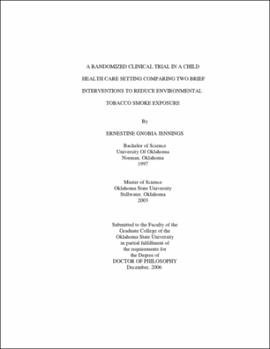| dc.contributor.advisor | Collins, Frank L., Jr. | |
| dc.contributor.author | Jennings, Ernestine Gnobia | |
| dc.date.accessioned | 2013-11-26T08:27:40Z | |
| dc.date.available | 2013-11-26T08:27:40Z | |
| dc.date.issued | 2006-12 | |
| dc.identifier.uri | https://hdl.handle.net/11244/6951 | |
| dc.description.abstract | Scope: The present study tested whether a brief intervention emphasizing a Smoke-Free home message compared to an intervention emphasizing a Smoking Cessation message with smoking caregivers, would lead to lower levels of passive nicotine monitor readings in the home after discharge from an intensive care nursery. Given the likely importance of motivational variables in the successful initiation and maintenance of smoking behavior change, the present study also sought to examine the utility of a brief ETS reduction intervention for increasing intentions to change for having a Smoke-Free home. Method: Fifty-three smoking caregivers of infants admitted to a Neonatal Intensive Care Unit were randomly assigned to one of three groups. The Usual Care Group (TAU) received brief information about the hazards of ETS exposure routinely provided by nursing staff at discharge along with some advice from their physician. Both the Smoking Cessation Group (CESS) and the Smoke-Free Group (SFH) received a brief intervention following the Clinical Practice Guideline for Treating Nicotine Dependence. An additional 25 non-smoking caregivers were recruited as a comparison group. Initial measures of caregiver smoking were assessed using a carbon monoxide (CO) monitor and caregiver-report. Alternative measures of success (i.e., harm reduction) included progression along the stages of change model as measured by the Stages of Change Algorithm. Groups were compared on nicotine monitor levels in the home and parent report of smoking at three months post hospitalization. Additional analyses were run to determine the relationship of the Stage of Readiness to stop smoking on the rate of ETS exposure in the home. Findings: The results indicated passive nicotine monitor readings for smoking caregivers who did not receive any intervention had significantly different passive nicotine monitor readings at follow-up (8.54 microg/m3) when compared to the intervention groups (2.57 microg/m3) and the non-smoking control group (0.35 microg/m3). No significant differences were found between the smoking caregivers in number of cigarettes smoked at follow-up. However, there were slight differences in Readiness to Change to have a Smoke-Free Home between the intervention groups and the Treatment as Usual control group at the three-month follow-up. | |
| dc.format | application/pdf | |
| dc.language | en_US | |
| dc.rights | Copyright is held by the author who has granted the Oklahoma State University Library the non-exclusive right to share this material in its institutional repository. Contact Digital Library Services at lib-dls@okstate.edu or 405-744-9161 for the permission policy on the use, reproduction or distribution of this material. | |
| dc.title | Randomized clinical trial in a child health care setting comparing two brief interventions to reduce environmental tobacco smoke exposure | |
| dc.contributor.committeeMember | Chaney, John M. | |
| dc.contributor.committeeMember | Leffingwell, Thad Ryan | |
| dc.contributor.committeeMember | Wiener, Joshua L. | |
| osu.filename | Jennings_okstate_0664D_2132 | |
| osu.accesstype | Open Access | |
| dc.type.genre | Dissertation | |
| dc.type.material | Text | |
| thesis.degree.discipline | Clinical Psychology | |
| thesis.degree.grantor | Oklahoma State University | |
